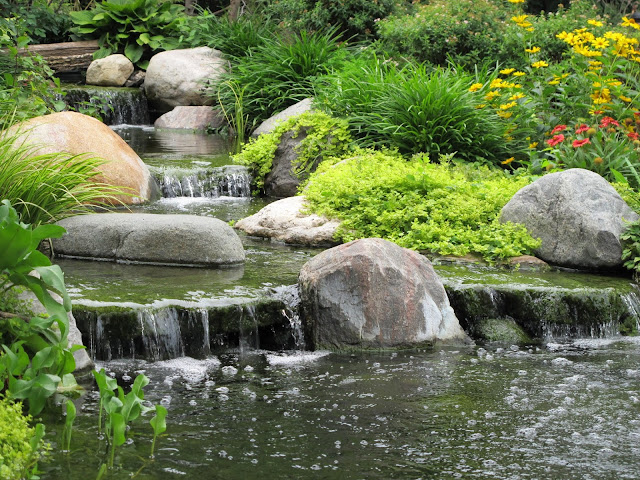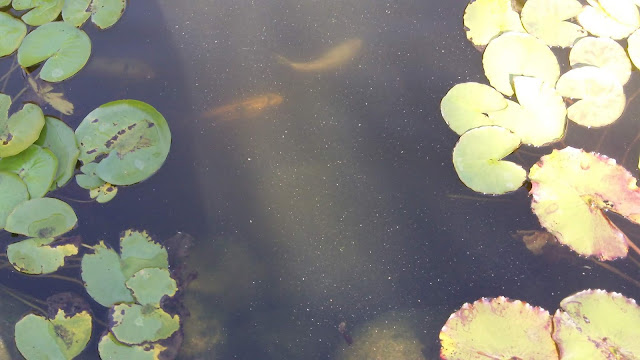Benefits of Adding a Creek to Your Pond
Sight, Sound and Health Benefits
Whether you call it a creek, a stream, or a "crick," the part of the water feature that connects the waterfall to your pond is an important part of your water feature.
We always recommend and install biological filters on our Cool Ponds water features. That is where the “waterfalls” on our features originate. But the creek is not just an area that connects the two parts. It has benefits too!
 |
| Here are some of the basic terms we use at Cool Ponds. |
We always recommend and install biological filters on our Cool Ponds water features. That is where the “waterfalls” on our features originate. But the creek is not just an area that connects the two parts. It has benefits too!
 |
| Creeks come in all sizes -- this large creek does most of the filtering on this pond. |
Our creeks are sometimes straight and sometimes curved. Often times they will have more small waterfall drops over flat stones along the way back to the pond. They create currents and ripples along with gurgling noise and sometimes small splashes.
We do our best to mimic what one would see out hiking in the woods in Indiana. Our creeks have rock sides, gravel bottoms and flat stones or logs where debris has backed up and created twists, turns and waterfall drops.
We do our best to mimic what one would see out hiking in the woods in Indiana. Our creeks have rock sides, gravel bottoms and flat stones or logs where debris has backed up and created twists, turns and waterfall drops.
The question is-- should your pond have a creek?
Aside from the aesthetic appeal and the auditory bonus, your creek serves some other functions as well.
Creeks are a great way to regulate water temperatures. As water passes through the air over a waterfall, the water temperature will change. Water cools much slower than air. So on a cool night when the air temperature has been warm during the day, although the air temperature is cold, the water temperature will still be warm. Water flowing over the falls can cool very quickly when exposed to the air during the falling.
While fish are cold blooded and their body temperatures do adjust to our changing environment, they can not change quickly. If the water temperature changes too rapidly the fish can become weak and sick. That can lead to health issues the same as it does for us when we are weak.
A creek helps to warm the water back up while it is flowing over gravel that is still warm from the day. That way the water from the waterfall does not fall directly onto the pond surface cooling the pond water too quickly.
Plus, cold water falling from a waterfall directly into the pond will fall directly to the bottom of the pond mixing with the warm water and cooling the entire pond.
A creek usually flows more gently into the pond -- the water mixes at the surface not changing the warmer water at the bottom. This allows the fish to adjust at a healthy rate to the cooler water.
Creeks are a great way to regulate water temperatures. As water passes through the air over a waterfall, the water temperature will change. Water cools much slower than air. So on a cool night when the air temperature has been warm during the day, although the air temperature is cold, the water temperature will still be warm. Water flowing over the falls can cool very quickly when exposed to the air during the falling.
While fish are cold blooded and their body temperatures do adjust to our changing environment, they can not change quickly. If the water temperature changes too rapidly the fish can become weak and sick. That can lead to health issues the same as it does for us when we are weak.
A creek helps to warm the water back up while it is flowing over gravel that is still warm from the day. That way the water from the waterfall does not fall directly onto the pond surface cooling the pond water too quickly.
Plus, cold water falling from a waterfall directly into the pond will fall directly to the bottom of the pond mixing with the warm water and cooling the entire pond.
 |
| Notice that with a waterfall flowing directly into the pond, cold air mixes deep into the pond, lowering the thermocline (the division between the warm water at the bottom and cold water at the top). |
 |
| With water flowing gently into the pond through a creek, the thermocline remains high in the pond, giving the fish plenty of warm, safe water at the bottom of the pond. |
A creek usually flows more gently into the pond -- the water mixes at the surface not changing the warmer water at the bottom. This allows the fish to adjust at a healthy rate to the cooler water.
 |
| Simply vac the creek a few times a year to keep your pond crystal clear and free of debris. |
Creeks are also excellent filters. Ponds always have some type of floating debris in them. Sometimes it’s particles that blow in, dead algae or fish waste. Whatever it is can make the water seem cloudy or green with algae. A properly installed creek will filter much of this floating junk out of your pond.
As particles in the water flow over gravel in a creek the water lifts over the gravel and the debris which is heavier than the water drops in between the gravel. It can also be deposited in slower moving water as the creek make twists and turns. The faster water on the inside of the turn moves swiftly through the turn and the outside water slows down, leaving behind a debris field under the water.
At my house I clean my falls and creek each year, not the pond. The pond is three and a half feet deep and crystal clear. My creek gets very full of debris. So full that sometimes you can not even see the gravel. Wow, what a great debris filter.
 |
| Look at the debris built up in this creek! That creek is definitely doing its job. |
As particles in the water flow over gravel in a creek the water lifts over the gravel and the debris which is heavier than the water drops in between the gravel. It can also be deposited in slower moving water as the creek make twists and turns. The faster water on the inside of the turn moves swiftly through the turn and the outside water slows down, leaving behind a debris field under the water.
At my house I clean my falls and creek each year, not the pond. The pond is three and a half feet deep and crystal clear. My creek gets very full of debris. So full that sometimes you can not even see the gravel. Wow, what a great debris filter.
Creeks are also a fantastic place to plant marginal aquatic plants. The plants we like help naturalize the creek sides and give us color to enjoy, but they also do a fantastic job consuming nutrients from the pond. They help to “starve” algae from our features by being the first plants that get to eat at the table. We certainly have some favorites for the creeks.
 |
| In this photo the creek flows in from the bottom of the photo. Where the creek meets the pond you can see lots of aquatic plants in the creek -- hibiscus, pickerel, thalia. |
If you don’t currently have a creek on your pond, you may want to consider the addition. They are healthy for the fish, great debris filters and an easy place to add beneficial aquatic plants to your water garden. They are also a great visual and auditory pleasure for anyone who enjoys relaxing by their pond like we do.
Written by Steve Wicker
Co-Owner Cool Ponds




Comments